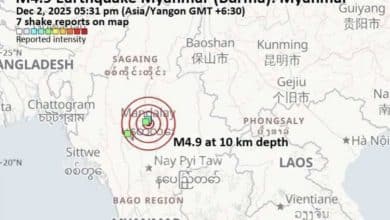World News
World news, global politics, business, technology, and culture—stay updated with breaking stories, international trends, and major events. Get the latest from The Thaiger, your trusted source for global news.
-

What’s happening in Iran? How hunger protests turned into a fight to topple the Islamic Republic.
Iran is currently cut off from the outside world. The government has severed internet and telephone lines nationwide, hoping to blind and deafen the international community to the brutality of its crackdown. Yet, the screams of frustration from the streets echo far beyond the digital blackout. This nationwide uprising is a clear signal: the 40-year-old theocratic regime is facing its…
-

Thai students claim top prize at Harbin snow sculpture contest
Thai vocational students from Bangkok and Chiang Rai won the 2026 International Collegiate Snow Sculpture Contest in Harbin, China, with a sculpture inspired by the Siamese fighting fish and goddess of water. The annual snow sculpture contest, organised by Harbin Engineering University, returned for its 18th edition this year. The competition was held from January 4 to 7 in Harbin,…
-

New ‘Republic of Kawthoolei’ announced at Thai-Myanmar border
The son of a former leader of the Karen National Union (KNU) declared independence and announced the establishment of the Republic of Kawthoolei, a self-proclaimed state located along the Thai–Myanmar border. Nerdah Mya, the son of former KNU leader Bo Mya, introduced himself as the first president of the Republic of Kawthoolei, meaning “the land without darkness” in Karen, on…
-

Cambodia accused of covering up Angkor Wat YouTuber assault
A travel YouTuber, known as The Country Collectors, who was assaulted at Cambodia’s Angkor Wat, posted a statement yesterday, January 7, that the Cambodian government has now attempted to cover up the story. In his statement posted on social media, the YouTuber said the APSARA National Authority, responsible for overseeing Angkor Archaeological Park, released an official response to the story.…
-

New fraud center compound found in Cambodia, 50 km from Poipet
Authorities have identified a new large-scale scam compound operating in Cambodia, around 50 kilometres from Poipet, raising fresh concerns over the regional spread of online fraud networks targeting victims worldwide. The Anti-Online Fraud Center, known as ACSC, confirmed the discovery on January 5, 2026, warning that criminal syndicates are rapidly relocating and expanding after recent coordinated crackdowns in Thailand, China,…
-

Thailand calls for restraint amid US-Venezuela tensions
Thailand’s Ministry of Foreign Affairs yesterday, January 4, issued a statement calling for restraint amid escalating tensions between the United States and Venezuela. The US launched a military strike across northern Venezuela on Saturday, January 3, under an operation named Operation Absolute Resolve. During the raid, Venezuelan President Nicolás Maduro and his wife, Cilia Flores, were captured following allegations that…
-

Royal Thai Navy detains 67 Cambodian migrants attempting illegal border crossing into Thailand
The Royal Thai Navy has detained 67 Cambodian migrant workers who attempted to illegally cross the Thai border in Chanthaburi province, authorities confirmed on January 3, 2026. The group included men, women, and children who officials said were fleeing severe economic hardship, unemployment, and food insecurity in their home communities. Rear Admiral Parach Rattanachaiyapan, spokesperson for the Royal Thai Navy,…
-

“I Paid For It!” Chinese guest fumes after being stopped from packing buffet food
Mother and Son Cause Scene at Hotel Buffet Over ‘No Takeaway’ Ban, Threaten Staff SUZHOU — A heated altercation erupted at a hotel in Suzhou, Jiangsu Province, after a mother and son were stopped from packing food from the breakfast buffet to take home. it escalated into a physical confrontation after the guests refused to comply with hotel regulations. Witnesses…
-

Body of Missing 19-Year-Old Texas Teen Found After Christmas Eve Disappearance
Tragic End: Body of Missing 19-Year-Old Texas Teen Found After Christmas Eve Disappearance SAN ANTONIO, TEXAS — The desperate search for Camila Mendoza Olmos, 19, who vanished on Christmas Eve, has concluded with a heartbreaking discovery. Bexar County Sheriff Javier Salazar confirmed on Tuesday afternoon that search teams located a lifeless body in a field near the residential area where…
-

Thai and Cambodian diplomats meet in China to reinforce ceasefire and border stability
Top diplomats from Thailand and Cambodia met in China on Sunday for high-level talks aimed at reinforcing a fragile ceasefire and preventing a return to fighting along their disputed border, as Beijing steps up its role as a regional mediator. The meetings follow the signing of a new ceasefire agreement intended to halt weeks of clashes that have killed more…
-

Trump says Thailand-Cambodia peace achieved with ‘very little assistance’ from UN
US President Donald Trump said yesterday, December 28, that Thailand and Cambodia returned to peace following a recent ceasefire agreement, claiming the outcome was achieved with “very little assistance” from the United Nations (UN). Trump made the statement on his social media platform, Truth Social, shortly after the ceasefire agreement between Thailand and Cambodia was reached on Saturday, December 27. In…
-

Thai army reports heavy clashes in Sisaket as border tensions stay high
The 2nd Army Region has released its latest summary of fighting along the Thai-Cambodian border, saying tensions remained high on December 26, particularly in Sisaket province, where heavy exchanges of fire were reported throughout the day. According to the army, clashes were concentrated across multiple points along the border, but Thai forces retained control of all strategic areas. In Ubon…
-

Cambodian men charged over attack on Thais in South Korea
Four Cambodian men were arrested today, December 26, and charged in South Korea after allegedly attacking two Thai nationals with glass bottles on the morning of December 7 in Yeongam county, South Jeolla province. The assault took place on the morning of December 7 in the Samho-eup area of Yeongam county, South Jeolla province, when a group of four Cambodian…
-

Thai tutor confronts foreign man shouting ‘Ni Hao’ and urges others to speak up
A Thai English-language tutor and social media influencer shared her experience of confronting a foreign man who shouted “Ni Hao” at her, urging others not to stay silent when faced with similar behaviour. The influencer, Warinthorn “Ann” Euawasinthon, widely known as Kru P’Ann, is the founder of Learnovate and a popular online educator. She has more than 1.7 million followers…
-

South Korean celebrity Hwang Hana returns home and surrenders to drug charges
A South Korean celebrity, Hwang Hana, who was wanted under an Interpol Red Notice, returned to her home country yesterday, December 24, and surrendered to authorities to face legal proceedings over drug-related offences. The 37 year old celebrity is widely known as the granddaughter of the founder of Namyang Dairy Products, one of South Korea’s major food companies. She is…
-

Trump reclassifies cannabis in major US drug policy shift
US President Donald Trump has ordered a change to federal drug regulations, signing an executive order to downgrade cannabis from a Schedule I to a Schedule III narcotic, the most significant shift in American drug policy in decades. The reclassification would place cannabis in the same category as ketamine, anabolic steroids, and Tylenol with codeine, substances considered to have legitimate…
-

Malaysia thanks Thailand for role in repatriation of online scam victims
Malaysia has formally thanked Thailand for its coordination and assistance in the successful repatriation of 31 Malaysian nationals who were victims of an online job scam in Myawaddy, Myanmar. According to reports by Asian News Network and The Straits Times, Malaysia’s Ministry of Foreign Affairs confirmed that all 31 victims were safely repatriated on the evening of December 20 and…
-

US trade deal on hold as tariffs could rise if border conflict drags on
A senior official at Thailand’s Ministry of Commerce has warned that any trade deal with the United States cannot be finalized until a new parliament and cabinet are in place, as concerns grow that Washington could raise tariffs if fighting between Thailand and Cambodia is not resolved. Speaking on Friday, Chotima Iamsawadikul, director-general of the Department of International Trade Negotiations,…
-

ASEAN steps in as Thailand-Cambodia border war tests regional unity
The Association of Southeast Asian Nations (ASEAN) foreign ministers will meet in Malaysia on Monday in a renewed attempt to stop escalating violence along the Thailand-Cambodia border, as clashes spread across disputed territory and humanitarian pressures intensify. The talks in Kuala Lumpur come after weeks of fighting that have left at least 40 people dead and forced more than 500,000…
-

6 Thai masseuses arrested for prostitution during raid on spa in Taiwan
Police in Taiwan raided a spa in Tainan City and arrested six Thai masseuses for allegedly providing illegal sex services. A Taiwanese customer was also arrested after being caught engaging in sexual activity during the operation. Officers from Shanhua Police Station carried out the raid on December 10 after receiving a tip-off that the spa was secretly operating as a brothel.…
-

Taiwanese man arrested for running prostitution ring involving 16 Thai women
Taiwanese police arrested a Taiwanese man for running a prostitution ring involving 16 Thai women, including his own girlfriend, who acted as a translator and helped recruit more Thai sex workers to Taiwan. Taiwan’s National Immigration Agency (NIA) announced the successful crackdown on a transnational prostitution network on Friday, December 12. Although the operation was carried out in June, the…
-

Trip.com halts cooperation with Cambodia amid privacy concerns
Online travel agency Trip.com cancelled its cooperation agreement with Cambodia’s tourism authorities after Chinese and Thai users reportedly expressed fears that their personal information could be leaked or misused. According to a recent report by Chinese local news outlet ST Headline, Trip.com had entered into a tourism promotion partnership with Cambodia’s National Tourism Authority (NTA). The agreement was signed on December…
-

Israel confirms identity of Thai hostage’s body from Gaza
The Israeli Prime Minister’s office has confirmed that the Red Cross handed over the body of Thai national Sudthisak Rintalak on Wednesday, December 3. Only one deceased hostage remains in Gaza, 24 year old Ran Gvili, an Israeli police officer. Sudthisak and Gvili were the final two hostages who had not been recovered from the territory. The Palestinian Islamic Jihad’s (PIJ)…
-

Thailand and UAE mark 50 years of diplomatic relations
Thailand and the United Arab Emirates (UAE) marked 50 years of diplomatic relations this week during a ceremony held at the UAE Embassy in Bangkok. The celebration coincided with the UAE’s 54th Union Day. UAE Ambassador to Thailand, Obaid Saeed Obaid Bintaresh Aldhaheri, addressed the attendees on Monday, praising the steady growth of bilateral ties. He remarked that the long-standing…
-

Myanmar rocked by 13 earthquakes in one week
A popular Thai weather monitoring Facebook page has issued a warning about increased seismic activity in Myanmar. Today, December 3, the page “Tee Lomfah Akat” reported that three earthquakes struck Myanmar overnight from December 2 into the early hours of December 3. The page reported the earthquake around the Sagaing Fault Line, where a powerful quake earlier this year caused…
-

Air France launches direct Paris to Phuket flights
Air France has launched a new direct route from Paris to Phuket, with its first flight arriving at Phuket International Airport yesterday morning, November 28, marking the return of seasonal service between France and Thailand’s southern tourist hub. Flight AF156, operated by a Boeing 777-200, landed at 9.25am after departing Paris Charles de Gaulle Airport the previous evening. The route…
-

Vietjet Thailand lands first Boeing 737 to boost Asia routes
Vietjet Thailand has received its first Boeing 737-8 in Bangkok, marking the start of a major fleet expansion to meet growing demand across Asia. This marks a major leap in the airline’s ambitious US$32 billion (1.15 trillion baht) fleet expansion programme across the Asia–Pacific region. The aircraft was delivered on November 22 at Bangkok’s Suvarnabhumi International Airport and is the…
-

Cathay Pacific sees Thailand rebound after rocky first half
Cathay Pacific confirmed it is seeing a strong rebound in Thailand route performance, after earlier struggles caused by safety concerns and political instability. Hong Kong’s flagship carrier confirmed that its Thailand routes are bouncing back in the second half of the year, following earlier setbacks tied to safety concerns and political instability. Despite a soft performance earlier in 2025, the…
-

Chinese tourist dies in budget hostel Bali after Suspected pesticide poisoning
Indonesia – A backpacking trip to Bali ended in tragedy for a 25-year-old Chinese tourist found dead in her hostel bunk. What began as a dream holiday turned into a nightmare at a budget accommodation in the popular Canggu district. Deqing Zhuoga was staying at the Clandestino Hostel, known for its $9-a-night rates. The hostel is now the focus of…
Broke? Find employment in Southeast Asia with JobCute Thailand and SmartJob Indonesia. Rich? Invest in real estate across Asia with FazWaz Property Group or get out on a yacht anywhere with Boatcrowd. Even book medical procedures worldwide with MyMediTravel, all powered by DB Ventures.





























